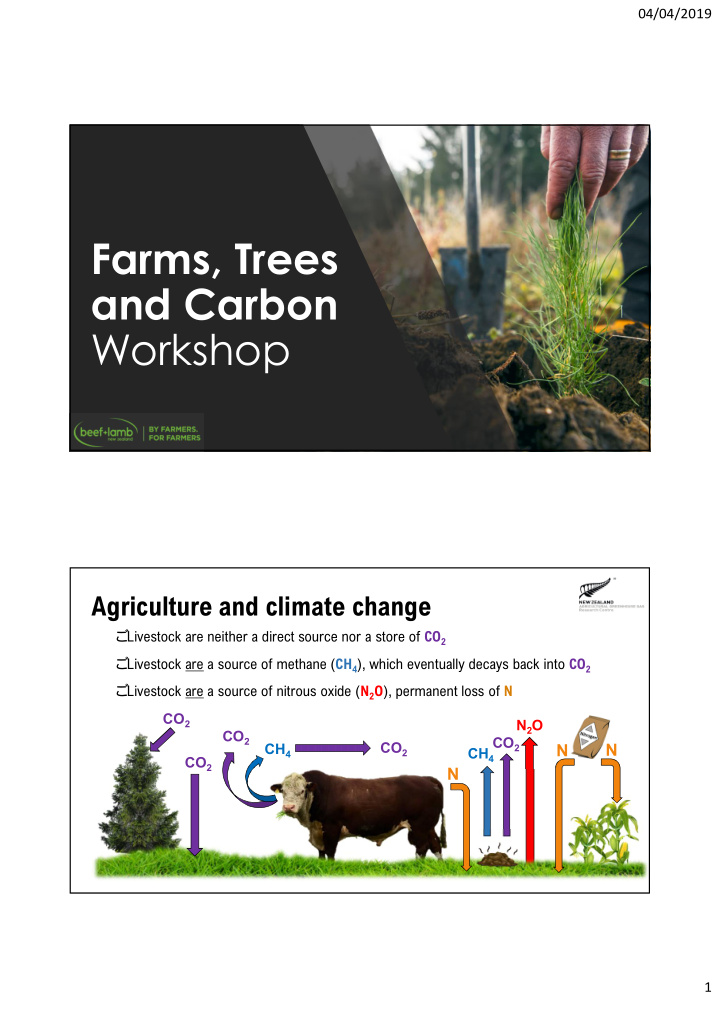



04/04/2019 Farms, Trees and Carbon Workshop Agriculture and climate change Where do livestock emissions come from • Livestock are neither a direct source nor a store of CO 2 • Livestock are a source of methane ( CH 4 ), which eventually decays back into CO 2 • Livestock are a source of nitrous oxide ( N 2 O ), permanent loss of N CO 2 N 2 O CO 2 CO 2 CO 2 CH 4 N N CH 4 CO 2 N 1
04/04/2019 What can farmers do? Keep getting the most out of your farm Use resources more efficiently to increase outputs: Improve stock Get Farm level GROW TREES Improve genetics report on your income, pasture farm emissions Incr. biodiversity, quality + feed shade & shelter, Improve utilisation Lower reduce sediment, animal health stocking rates store carbon farm emission offset ETS - Compliments good land use decisions Right species … Right place Pole plantings Riparian/stock exclusion Plantation Forestry Indigenous/retired 2
04/04/2019 Baseline date - Kyoto 31 December 1989 1 January 1990 _ _ _ _ _ _ _ _ _ _ _ _ _ _ _ _ Was ‘ forest land ’ at 31 Dec 1989 Became ‘ forest land ’ from 1 Jan 1990 and predominantly EXOTIC in 2008 or change of land use / not forest can apply for ‘ Offset ’ to new location land for longer than 4 years “ Pre-1990 ” “ Post-1989 ” Pre-1990 Deforestation 2 hectares or more deforested (change of land use) by the same entity, within legal boundary, within 5 year compliance periods. (eg: 2013 – 2017) Obligation = surrender of units equivalent to carbon released Penalty if not notified in time = up to $30 to MPI and $30 to EPA per unit 3
04/04/2019 NZ Emissions Trading Scheme • NZ ’ s Domestic carbon market designed to reduce total carbon emissions • Voluntary participation (Post-1989 land) • 5 year compliance periods i.e. 2008 – 2012 … 2013 – 2017 … 2018 – 2022 • Gain carbon units based on increase of carbon in a calendar year • Pinus radiata (regional), Hardwood, Softwood, Indigenous, Douglas Fir • Over 100 hectares registered (FMA) must measure actual carbon present Carbon - Species Comparison 4
04/04/2019 Carbon – Exotic Regimes 80 Trees thinned 70 60 UNTHINNED tonnes carbon/ha/year 50 40 THINNED 30 MPI Standard 20 Tables 10 0 1 2 3 4 5 6 7 8 9 10 11 12 13 14 15 16 17 18 19 20 21 22 23 24 25 26 27 28 29 30 31 32 33 34 35 Age of trees Enduring Carbon Opportunity - Current Enduring ‘ low risk ’ carbon The lowest point of total carbon when replanted – multiple rotations Depends on age felled ‘ low ’ risk ’ / enduring carbon and year replanted Must have claimed years 1-10 of the 1 st crop 5
04/04/2019 ETS Review / Consultation Averaging Accounting approach = the average total carbon across rotations Harvested Wood Products Average total carbon (HWP) - Add increase to carbon tables or - Create an “ industry good ” fund to develop longer lived HWP Permanent Post-1989 - Like a Permanent Forest Sink (50yrs) - Not capped at average Spaced plantings - ETS eligibility tips • Narrow varieties = Less canopy • New poles - Max 4m buffer but 20m on perimeter 4m poles 20m 20m 15m • Younger poles need higher stems per hectare (SPH) max 20m 4m • Mature trees eligible based on drip line (max 15m to edge) 15m max 6
04/04/2019 Spaced/Riparian plantings - tips • Survival … . Location and spacing crucial (monitor & replant) • Assess >30% canopy cover potential well met • Irregular shapes … . Link / increase existing poles • Use to buffer narrow / riparian areas • Determine age - Establishment records (evidence) • Over 100 ha (FMA) measure actual carbon present (less) Potential carbon • Peak growth per hectare in years 6 - 10 • Annual growth plateaus around years 20 - 25 onwards Other exotic Hardwoods YEARs 1 - 5 6 – 10 11 -15 16 - 20 21 - 25 26 - 30 NZU for 5 year period 63 188 158 117 92 67 NZU TOTAL accrued 63 251 409 526 618 685 Source: MPI standard Look-up tables 7
04/04/2019 Farm Example 483 ha Northland Radiata Solution … Right species right place: - Plant 45 Ha pine Pole plantings Solution: Link existing pole plantings to Mature create 26 ETS eligible Ha Indigenous Forest Riparian and stock exclusion areas Solution - plant: - Poles outside fenced area to create 30m avg - Pollen producing trees - Hives and carbon opportunities Farm Emission Profile Example Emissions 2018 3,460 (3,444 SU = 1.005 CO 2 e per SU) 1990 Running similar numbers Target 11% below 1990 Target is 3,114 CO 2 e Reduction required of 346 units Plant 45 Ha Pine Average of 812 NZU/year Plant 26 Ha Poplar Average of 594 NZU/year Stream plantings Average of 80 NZU/year Total NZU opportunity 1,486 NZU/year (+180..from SU reduction) 1,666 reduction achieved – 346 reduction required 8
04/04/2019 Farm Net Benefit (30 years) 48% Emission reduction below 1990 levels • Reduced sediment run off • Increased pollination services from year round hive placement • Increased bird life/other biodiversity 30 Year Revenue • At a loss of 180 SU Hive rental $150,000 39,600 NZU (@ $25/NZU) $999,000 - $253,800 revenue Tree harvest revenues $1,175,895 Sub-total $2,324,895 Less stock unit revenue $253,800 Total $2,071,095 How is this useful? • Farm story and web site • ‘ Land environmental plan ’ (LEP) species placement and selection • Carbon profile … past present and future • Funding applications • ETS applications • Succession planning /exit strategy 9
Recommend
More recommend